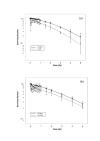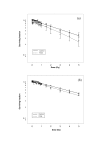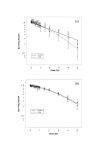A general framework for quantifying the effects of DNA repair inhibitors on radiation sensitivity as a function of dose
- PMID: 17640390
- PMCID: PMC1950494
- DOI: 10.1186/1742-4682-4-25
A general framework for quantifying the effects of DNA repair inhibitors on radiation sensitivity as a function of dose
Abstract
Purpose: Current methods for quantifying effects of DNA repair modifiers on radiation sensitivity assume a constant effect independent of the radiation dose received. The aim of this study was to develop and evaluate a modelling strategy by which radiation dose dependent effects of DNA repair inhibitors on clonogenic survival might be identified and their significance assessed.
Methods: An indicator model that allowed quantification of the Sensitiser Effect on Radiation response as a function of Dose (SERD) was developed. This model was fitted to clonogenic survival data derived from human tumour and rodent fibroblast cell lines irradiated in the presence and absence of chemical inhibitors of poly(ADP-ribose) polymerase (PARP) activity.
Results: PARP inhibition affected radiation response in a cell cycle and radiation dose dependent manner, and was also associated with significant radiation-independent effects on clonogenic survival. Application of the SERD method enabled identification of components of the radiation response that were significantly affected by PARP inhibition and indicated the magnitude of the effects on each component.
Conclusion: The proposed approach improves on current methods of analysing effects of DNA repair modification on radiation response. Furthermore, it may be generalised to account for other parameters such as proliferation or dose rate to enable its use in the context of fractionated or continuous radiation exposures.
Figures



Similar articles
-
Modification of survival by DNA repair modifiers: a probable explanation for the phenomenon of increased radioresistance.Int J Radiat Biol. 2000 Mar;76(3):305-12. doi: 10.1080/095530000138646. Int J Radiat Biol. 2000. PMID: 10757310
-
PARP-1, PARP-2, and the cellular response to low doses of ionizing radiation.Int J Radiat Oncol Biol Phys. 2004 Feb 1;58(2):410-9. doi: 10.1016/j.ijrobp.2003.09.053. Int J Radiat Oncol Biol Phys. 2004. PMID: 14751510
-
Trans-dominant inhibition of poly(ADP-ribosyl)ation leads to decreased recovery from ionizing radiation-induced cell killing.Int J Radiat Biol. 1998 Mar;73(3):325-30. doi: 10.1080/095530098142428. Int J Radiat Biol. 1998. PMID: 9525261
-
Involvement of poly (ADP-ribose) in the radiation response of mammalian cells.Int J Radiat Biol Relat Stud Phys Chem Med. 1984 Dec;46(6):659-71. doi: 10.1080/09553008414551891. Int J Radiat Biol Relat Stud Phys Chem Med. 1984. PMID: 6084645 Review.
-
Inhibition of homologous recombination repair with Pentoxifylline targets G2 cells generated by radiotherapy and induces major enhancements of the toxicity of cisplatin and melphalan given after irradiation.Radiat Oncol. 2006 May 3;1:12. doi: 10.1186/1748-717X-1-12. Radiat Oncol. 2006. PMID: 16722614 Free PMC article. Review.
Cited by
-
Effects of variations in overall treatment time on the clonogenic survival of V79-4 cells: Implications for radiosurgery.J Radiosurg SBRT. 2019;6(1):1-9. J Radiosurg SBRT. 2019. PMID: 30775069 Free PMC article.
-
Depletion of signal recognition particle 72kDa increases radiosensitivity.Cancer Biol Ther. 2017 Jun 3;18(6):425-432. doi: 10.1080/15384047.2017.1323587. Epub 2017 May 11. Cancer Biol Ther. 2017. PMID: 28494188 Free PMC article.
-
Identification of vitamin B1 metabolism as a tumor-specific radiosensitizing pathway using a high-throughput colony formation screen.Oncotarget. 2015 Mar 20;6(8):5978-89. doi: 10.18632/oncotarget.3468. Oncotarget. 2015. PMID: 25788274 Free PMC article.
-
Current progress of RNA aptamer-based therapeutics.Front Genet. 2012 Nov 2;3:234. doi: 10.3389/fgene.2012.00234. eCollection 2012. Front Genet. 2012. PMID: 23130020 Free PMC article.
-
Prostate-targeted radiosensitization via aptamer-shRNA chimeras in human tumor xenografts.J Clin Invest. 2011 Jun;121(6):2383-90. doi: 10.1172/JCI45109. Epub 2011 May 9. J Clin Invest. 2011. PMID: 21555850 Free PMC article.
References
-
- Steel GG, Adams K. Stem-cell survival and tumor control in the Lewis lung carcinoma. Cancer Res. 1975;35:1530–1535. - PubMed
Publication types
MeSH terms
Substances
Grants and funding
LinkOut - more resources
Full Text Sources

